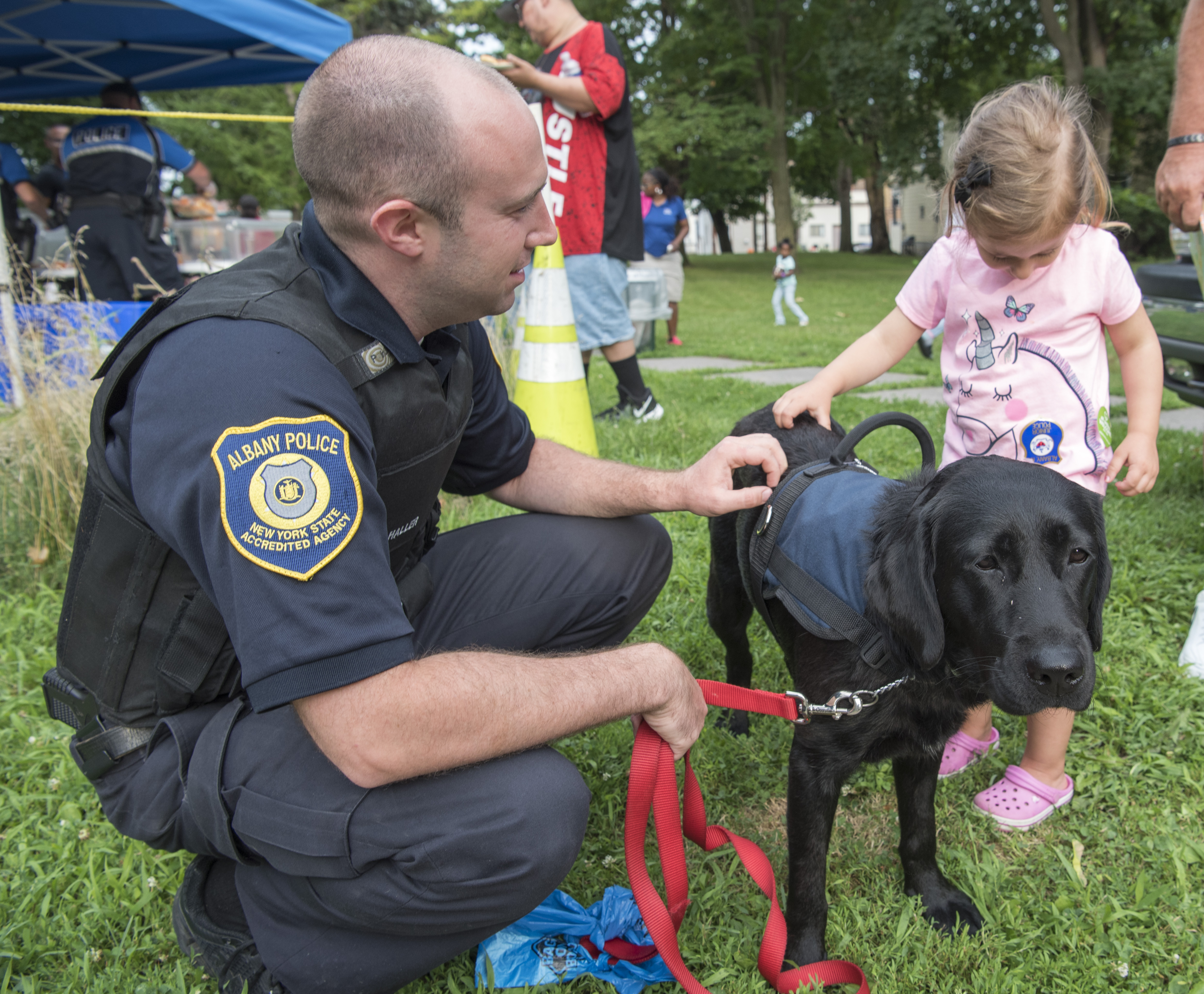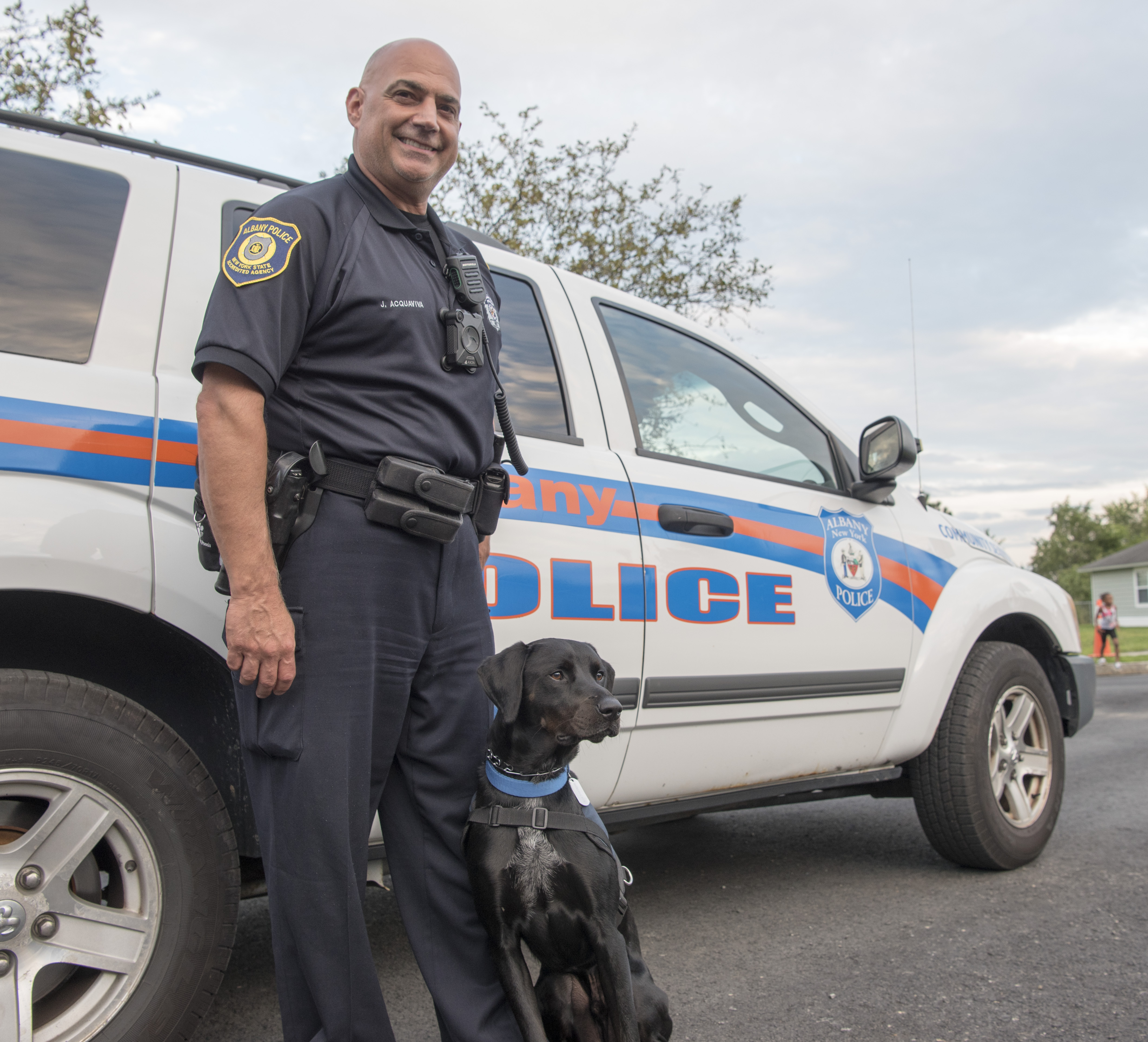Contact Us
To provide feedback on the Community Policing Dispatch, e-mail the editorial board at CPDispatch@usdoj.gov.
To obtain details on COPS Office programs, publications, and resources, contact the COPS Office Response Center at 800-421-6770 or AskCopsRC@usdoj.gov

U.S. Department of Justice
Office of Community Oriented Policing Services
Washington, DC 20530
 Probably one of the most lovable members of the Albany (New York) Police Department (APD) is Charlie the goldendoodle. As seen in this photo with his handler, Officer Joel Caldwell, he makes friends everywhere he goes.
Probably one of the most lovable members of the Albany (New York) Police Department (APD) is Charlie the goldendoodle. As seen in this photo with his handler, Officer Joel Caldwell, he makes friends everywhere he goes.
Charlie and his teammates Maxie and Finn are the APD’s three therapy dogs—and despite their warm and fuzzy appearance, they are important members of this law enforcement agency in New York’s capital city, where they have contributed significantly to positive community relationships and the department’s workforce wellness for the past four years.
They are also a big help in the field. Said APD Chief Eric Hawkins, “If there is a domestic violence situation, a traffic accident, or other incident that could result in trauma, a therapy dog can greatly ease anxiety and stress, especially with children. It can also improve outcomes by enabling positive interaction with officers on the scene.
Enabling Better Outcomes in the Field
Chief Hawkins gave the example of a domestic violence incident in which a child was under extreme stress and said many negative things to the officers on the scene.
“To help the boy calm down, the officers got his parents’ permission to bring Charlie,” said Hawkins. “And as soon as the dog arrived, the boy’s stress level dropped. He not only interacted with Charlie but became comfortable with the officers and gave them the information they needed to complete their report.”
In explaining how the dogs’ deployment works, Hawkins said, “They are assigned to the regular shifts of their three handlers, who are assigned to the Community Policing Unit. When patrol officers respond to calls in which they feel that Charlie or Maxie could be helpful, they ask the victims if they would like to have a comfort dog on the scene. If so, the officers will ask Charlie, Finn, or Maxie’s handler to bring their dog. If the dogs’ primary handlers are unavailable, we have backup officers who can bring them.”
Another example of the dogs’ value in the field was given by Commander Daniel Meehan, who manages the therapy dog program.
“Officers from our Crisis Negotiations team, including Joel Caldwell, responded to a call about a young teen who was experiencing mental health issues and was standing on the roof of her three-story home, threatening suicide. After trying to coax the girl down for several hours, they learned that she loved dogs. Caldwell brought Charlie to a window overlooking the roof, and the teen came to the window to meet the dog and was brought inside to safety.
“The dogs also do a lot of community work,” added Meehan. “They attract people and help us engage with children and adults at schools, nursing homes, picnics, neighborhood association meetings, and other events. It’s been a wonderful tool for us in building relationships.”
Contributing to Health and Wellness in the Department
 In the department, Charlie, Finn, and Maxie perform another important job: supporting the health, wellness and job satisfaction of officers and civilian staff.
In the department, Charlie, Finn, and Maxie perform another important job: supporting the health, wellness and job satisfaction of officers and civilian staff.
Said Hawkins, “The original impetus for developing this program was actually the officer health and wellness benefits. There were a lot of negative things going on in the country at the time, and we were seeing a high level of stress in our workplace. So we were looking for innovative strategies to boost morale for our administrative and sworn staff.”
Before starting the program, Hawkins asked for volunteers to create a committee to discuss whether a therapy dog program would work and how to set one up. Fourteen employees, sworn and non-sworn, from units across the agency volunteered.
“We saw comfort dogs being used in courts, airports, and other high-stress locations to relieve anxiety and reduce tension. And after doing some research, we realized that they could reduce stress and create a congenial atmosphere in our own workplace.
“They’re now at roll calls, in office space, and other places. Just hanging out in our stationhouses helps de-stress the environment and provide comfort to our people. You can see the professional staff light up when they come into their workspace. They create a healthy ambience and relax people.”
City of Hope research has shown that the presence of therapy animals can lower blood pressure and decrease anxiety. Just petting a dog can improve a person’s mood and increase their feeling of well-being, which can lead to better relationships within the department. Additionally, dogs can act as icebreakers in tense situations, creating a sense of safety that enables people to open up.
Said Meehan, “When we started out, the program got pushback from some of the rank and file. Officers can be hesitant to change, but now they are our biggest fans. They even carry treats in their pockets. Charlie and Maxie won over a lot of people.”
Funding and Donations from Breeders, Local Businesses and Non-Profits
As for funding and implementing the program, Hawkins and Meehan indicate that this was relatively easy. Maxie and Charlie were donated by a breeder, who also provided their initial training. According to Hawkins, many breeders are willing to donate animals if they will be used for a good cause.
 Finn was adopted from the Paws & Stripes College, a nonprofit program run by the Brevard County (Florida) Sheriff’s Office, which takes in rescue dogs and sends them to county jails, where inmates provide six to eight weeks of basic dog training. Law enforcement personnel who wish to adopt one of the dogs must also complete 40 hours of training in areas applicable to therapy dogs in an agency setting.
Finn was adopted from the Paws & Stripes College, a nonprofit program run by the Brevard County (Florida) Sheriff’s Office, which takes in rescue dogs and sends them to county jails, where inmates provide six to eight weeks of basic dog training. Law enforcement personnel who wish to adopt one of the dogs must also complete 40 hours of training in areas applicable to therapy dogs in an agency setting.
Said Meehan, “We went to Brevard County and learned things such as appropriate time[s] to use the dogs and how to deploy them effectively. Charlie, Finn, and Maxie then worked with a local trainer and earned their certifications through Therapy Dog International, a volunteer organization that regulates, tests, and registers dogs and their handlers. The dogs continue to train twice a month with the local breeder and are re-evaluated by Therapy Dog International annually.”
The veterinarian care and specialized therapy dog training is partially funded through the Albany Police and Fire Foundation, a nonprofit run by community members to generate support for innovative programs and equipment which can improve the effectiveness and professionalism of the police and fire departments. The APD also partnered with a local insurance company called MVP Healthcare, which provided additional funding for training and ancillary costs.
Charlie, Finn, and Maxie live with their handler officers. Local businesses donated grooming, crates, vests, and some food. The department also paid for the dogs’ food, as well as the vehicles, which are outfitted to carry them.
Said Meehan, “It’s pretty easy to get donations; a lot of people want to help with the dogs. The only big expense was getting the special vehicles.”
“We’re very proud of the program,” added Hawkins. “And so far, about 20 to 25 departments have reached out and asked for help setting up their program. It’s been an amazingly good thing for us—the public loves it and we do too.”
Images courtesy of Albany Police Department.
Faye C. Elkins
Sr. Technical Writer
COPS Office
Subscribe to Email Updates
To sign up for monthly updates or to access your subscriber preferences, please enter your email address in the Subscribe box.






